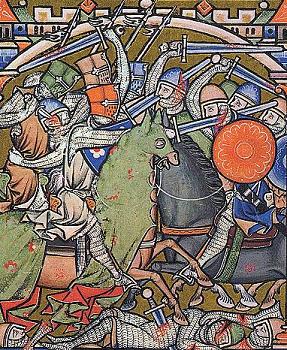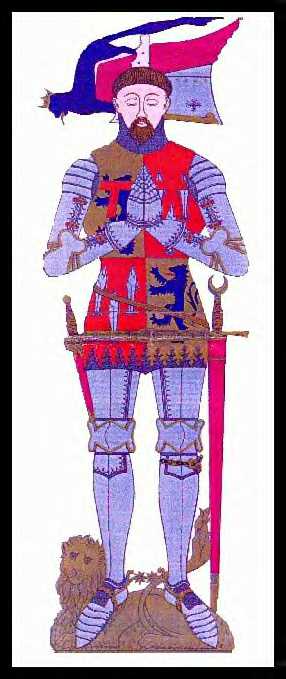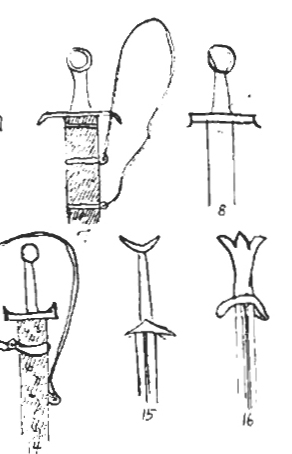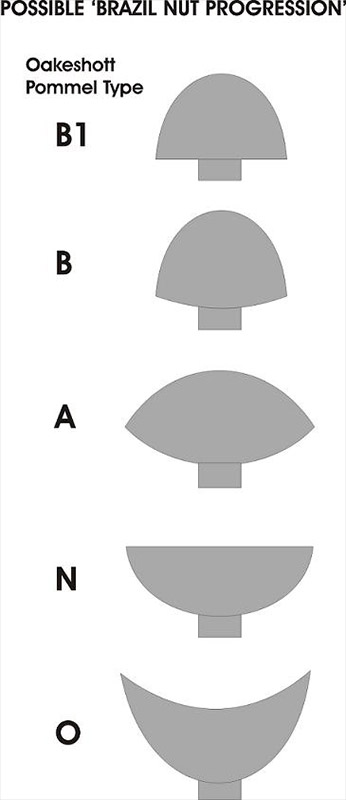| Author |
Message |
J.D. Crawford

|
 Posted: Fri 24 Dec, 2010 1:48 pm Post subject: A&A Custom 'type O' Pommel WarSword Project Posted: Fri 24 Dec, 2010 1:48 pm Post subject: A&A Custom 'type O' Pommel WarSword Project |
 |
|
BACKGROUND
Last October Craig Johnson (from Arms and Armour) and I were kicking around ideas for a early/high-medieval custom sword, with an eye toward doing something novel. After some discussion we settled on a sword with a “type O” pommel, a type so rare there are only 3 known specimens in existence, and popular English books on the subject only provide drawings based on swords portrayed in Medieval Art (as opposed to actual swords).
The original idea, for lack of an actual sword, was to reproduce a sword from a sculpture, but then I found an academic abstract on the web that referred to ‘type O’ swords, and Craig got hold of the full article from the author (Marko Aleksić), which turned out to have both written and pictorial information on two actual type O swords. We picked one of these to replicate, and the plans were set. The project got an extra kick-start when I simultaneously won Nathan Robinson’s “Pay it Forward Contest”: http://www.myArmoury.com/talk/viewtopic.php?t=21307
My intent here is to provide some educational background before the fun part starts (sorry, I'm a professor, I can't help it).
TYPE N AND O POMMELS
In Oakeshott’s nomenclature, type N pommels are boat shaped (curving away from the hand) whereas type O has an even stronger crescent-shaped curvature. (Type O) This group corresponds to Giebig’s type 17 classification (Type 17). N is a rare type, but type O even more-so. At the time of writing ‘the Sword in the Age of Chivalry’ Oakeshott was aware of only one type O in existence in a private collection. However, he refers to several depicted in sculptures at the Freiburg Cathedral (c1300) and he provides drawings of 3 of these (Oakeshott 1964/2006, p.99, Figs. 65, 66, 67). He also mentions that another is depicted in the Maciejowski Bible, but does not show it. According to Aleksić’ (2006), Giebig described an original sword to represent his type 17II pommel (Geibig 1991, 73-75, 150, 151, fig. 39).
Broadly speaking, looking at pommels of form B (tea cozy), A (Brazil Nut), N (Boat), and O (Crescent), and their sub-forms across the centuries, one can’t help but see (rightly or wrongly) both a commonality and a progression of more and more curvature away from the hand, perhaps for comfort, or perhaps for style. So, being one of those Brazil Nuts 'nuts' myself, I can't help but viewing type O as the last of the Brazil Nuts.
DISTRIBUTION, TYPING, AND DATING
Marko Aleksić’s article 'Swords with Pommels of Type N' (2006) provides a comprehensive review of the history, archeology, and typology of such swords. Although the focus is on type N, he treats type O as an associated class and provides descriptions of two such swords. Overall, he describes this entire group of swords as large bladed swords of type Xa in transition to XIII, usually with long (often type 1) crosses and hand-and-half grips.
Aleksić (2006) further explains that most of the known find places for these swords are either in German territories (mainly South) or in regions of Eastern Europe that were occupied by the Teutonic Knights. However, the two type ‘O’ swords described were found somewhere in Western Germany (apparently the same one described by Giebig) and another in the central Czech Republic. These are both large swords, with blades described as XII/XIIa and XVI, respectively. The German XII has an extremely long ~11” type 1 cross, and based on the drawing provided, I would estimate the handle length at 4.5-5”.
Both Aleksić (2006) and Oakeshott (1964/2006) use the Freiburg sculptures as a fixed dating point for type O, placing it at the end of the 13th century into the early 14th, and perhaps as the final form for this class (Aleksić 2006). The Czech type XVI would certainly agree with that assessment. However, the depiction in the Maciejowski Bible could point out an earlier date for some “O” swords (mid 13th century). Moreover, crescent-shaped pommels are depicted in the ‘Massacre of the Innocents’, a carving in the Liebfrauenkirche, Trier, Germany, which is dated to 1240 (Nicolle, p179, Fig. 458). This could suggest that type O and type N pommels co-existed, and in particular could allow for an earlier date of origin for the German XII described above.
MODERN REPLICAS
To my limited knowledge, only Windlass has replicated a type N sword (their ‘Naumburg Sword’) and I have never seen or found a replica of a type O sword (I will be pleased to learn otherwise). Even if more exist somewhere (either originals or replicas), clearly this is a rare type which deserves to be brought back to life for the sword-collecting community. Therefore, and according to my esthetic preference in swords, Craig Johnson has agreed to replicate the German XII described above. I will post pictures of Craig’s replica components as they become available in the following months.
Please feel free to point out any errors I may have made in this overview - this is not my area of professional expertise.
REFERENCES
Aleksić, M (2006) Swords With Pommel Type N, Slovenská archeológia LIV-2, 363-388
Geibig, A (1991) Beiträge zur morphologischen Entwicklung des Schwertes im Mittelalter. Neumünster.
Nicolle, D (1988/1999) Arms and Armour of the Crusading Era 1050-1350. Western Europe and the Crusader States. Greenhill/Stackpole Books.
Oakeshott, E (1964/2006) The Sword in the Age of Chivalry. Boydell and Brewer.
|
|
   |
 |
|
Tim Lison
|
 Posted: Fri 24 Dec, 2010 3:56 pm Post subject: Posted: Fri 24 Dec, 2010 3:56 pm Post subject: |
 |
|
JD-
Wow! A type O! Great choice. I'm excited to see it. I'm posting the pic from the Maciejowski Bible that Oakeshott refered to. It appears to be a type XII blade with a style 1 or 2 cross. Keep us updated as this sword develops!
 Attachment: 51.3 KB Attachment: 51.3 KB

|
|
  |
 |
Glen A Cleeton

|
 Posted: Fri 24 Dec, 2010 4:27 pm Post subject: Posted: Fri 24 Dec, 2010 4:27 pm Post subject: |
 |
|
Good taste in an O and something similar is in my long lists of wants as a variation of sorts for a XVa or XVIa. mAybe even just a modification of my existing bronze BP pommel but more likely a start from scratch. Not an O type is what I plan but to incorporate the 3d possibilities shown in 2d by my avatar.
Cheers
GC
 Attachment: 29.43 KB Attachment: 29.43 KB

|
|
  |
 |
J.D. Crawford

|
 Posted: Sat 25 Dec, 2010 4:18 am Post subject: Posted: Sat 25 Dec, 2010 4:18 am Post subject: |
 |
|
Thanks for the Graphics guys. I plan to post pictures of the original swords in the article referred to above, but would like to get permission from the author first. The pommel curvature in these swords is not quite so extreme as what we are seeing in artwork.
Tim, thanks for posting the bible painting, I hadn't seen it myself. That's very appropriate for the current project.
Glen, given your interest I will try to show the O-XVIa as well.
Craig is planning to heat treat the blade next week - if he is feeling photographic, we might be able to show off some shiny steel in the new year.
-JD
PS - Tim, now I can admit how close you were when you guessed 'type N'!
Last edited by J.D. Crawford on Sat 25 Dec, 2010 6:35 am; edited 1 time in total
|
|
   |
 |
|
Christopher Domanski
Location: Ireland Joined: 22 Feb 2010
Posts: 14
|
 Posted: Sat 25 Dec, 2010 6:30 am Post subject: Posted: Sat 25 Dec, 2010 6:30 am Post subject: |
 |
|
|
Nice find Glen! Would you consider posting some more info about that gentleman on the effigy? A name would suffice, but a date of death would be just terrific.
|
|
  |
 |
|
Tim Lison
|
 Posted: Sat 25 Dec, 2010 8:48 am Post subject: Posted: Sat 25 Dec, 2010 8:48 am Post subject: |
 |
|
| J.D. Crawford wrote: |
PS - Tim, now I can admit how close you were when you guessed 'type N'! |
Not quite though! Do have Craig post some pics of the blade if you can, in progress shots are great!
|
|
  |
 |
Glen A Cleeton

|
 Posted: Sat 25 Dec, 2010 3:09 pm Post subject: Posted: Sat 25 Dec, 2010 3:09 pm Post subject: |
 |
|
| Christopher Domanski wrote: | | Nice find Glen! Would you consider posting some more info about that gentleman on the effigy? A name would suffice, but a date of death would be just terrific. |
What was the best source for Perci/Percy information is now behind an archive .com link after geocities shut down pages. This should link to the second house of Percies at Alnwick (Potter's castle in modern fiction).
http://web.archive.org/web/20091027040015/htt...indit.html
The figure is a modern art effigy of Harry Percy (aka Hotspur) who was killed at Shrewsbury after leading a rebellion prompted by Henry IV denying wages and ransom funds due as an overall wedge between England and Scotland. It is a good long tri family story from the first (Princes) crusade up through the gunpowder plot and beyond. The various Percies often waving the losing flag of politics.
The pronounced crescent the art sword shows is undoubtedly adopted from the family badge but my feeling that Harry's favorite sword (moaned over when leaving it behind just before Shrewsbury) was more likely a less pronounced crescent but acquired by him because of an O type that fit/found his excuse for it. It may well have been much more similar to the Namburg sword or the XVIa now mentioned by J.D.
I had posted a more graphic version of the above on that page linked and I had also posted it to a thread on livery badges an several more times in heraldry threads.
http://web.archive.org/web/20091027115941/www...tspur.html
http://web.archive.org/web/20091027145009/www...spur1.html
Cheers
GC
|
|
  |
 |
Maurizio D'Angelo

|
 Posted: Thu 30 Dec, 2010 5:15 pm Post subject: Posted: Thu 30 Dec, 2010 5:15 pm Post subject: |
 |
|
Perhaps the ancestors of this type of pommel.
(Fig. 16, 15). This pommel is not unknown from Scythian
and from Central Asiatic swords, where it as a rule is combined with
a very long grip and short quillons, narrowing towards the ends. It is
no imaginary type for it has counterparts in various Asiatic swords represented
in silver-bowls and in Turkestan wall-frescoes.
Ada Bruhn Hoffmeyer
Scythians of antiquity were amalgamated into the various Slavic groups of eastern and southeastern Europe.
a large bladed, tipical of the Alans tribes, with a pommel, half moon, was found in an ancient cemetery near the Black Sea
( Laz )
Kaminski
 Attachment: 54.48 KB Attachment: 54.48 KB

Ciao
Maurizio
|
|
   |
 |
J.D. Crawford

|
 Posted: Sat 01 Jan, 2011 11:51 am Post subject: Posted: Sat 01 Jan, 2011 11:51 am Post subject: |
 |
|
|
Thanks Maurizio, you've taught me something new. The assumption in Aleksić's article is that pommel type O originated in Germany and was imported by Crusaders into Slavic countries, so yours is an interesting alternative interpetation. -JD
|
|
   |
 |
Maurizio D'Angelo

|
 Posted: Mon 03 Jan, 2011 11:29 am Post subject: Posted: Mon 03 Jan, 2011 11:29 am Post subject: |
 |
|
| J.D. Crawford wrote: | | Thanks Maurizio, you've taught me something new. The assumption in Aleksić's article is that pommel type O originated in Germany and was imported by Crusaders into Slavic countries, so yours is an interesting alternative interpetation. -JD |
Professor J.D. Crawford, your modesty is equal to your great preparation. 
Mine is an interpretation.
My little knowledge about swords, lead me to think that pommel and guards commonly found in Europe have an imprint on pommel and guards of the past. This is plausible, especially with highly mobile populations with an example: the Avars.
Perhaps, I learned to think in compartments with regard pommel and guards with the date and place indicated by the master Oakeshott, but it is my limit, not the teaching of the master. I'm changing my way of thinking.
Regarding pommel and guards, I have trouble to report out of time and area of origin indicated by the great master.
I suspect that some pommel and guards found in the east, long before, they are then come to us, in Europe, two centuries late.
Obviously, the theory would need much more bibliographic support, but the drawings of the "Synopsis Historion" by John Skylitzes, there are many pommel and guards that seem familiar.
I can not wait to see the photos.
Thanks for posting this article very educational.
Ciao
Maurizio
|
|
   |
 |
J.D. Crawford

|
 Posted: Mon 03 Jan, 2011 12:24 pm Post subject: Posted: Mon 03 Jan, 2011 12:24 pm Post subject: |
 |
|
|
Thanks again Maurizio. By the way, I found another 'type N' replica here: http://www.berbekuczviktor.hu/
|
|
   |
 |
J.D. Crawford

|
 Posted: Tue 11 Jan, 2011 4:51 pm Post subject: Posted: Tue 11 Jan, 2011 4:51 pm Post subject: |
 |
|
OK, so here are what two of the three known 'type O' pommel swords actually look like.
#1 on the left is a type XII found somewhere in Western Germany. This is the inspiration for the sword that Craig Johnson at A&A is currently working on.
#2 on the right is an XVIa found near Pardubice, Czech Republic.
 Attachment: 19.84 KB Attachment: 19.84 KB

Type O Pommel Swords.
Modified and reprinted (by permission of the author) from Aleksić, M (2006) Swords With Pommel Type N, Slovenská archeológia LIV-2, 363-388
|
|
   |
 |
|
Jeremy V. Krause
|
 Posted: Tue 11 Jan, 2011 7:25 pm Post subject: Posted: Tue 11 Jan, 2011 7:25 pm Post subject: |
 |
|
Thanks for sharing J.D.,
That type XII is an excellent inspirational choice. The type XVI.a next to it isn't too shabby either, though of a later date i'd gather. I guess this type O may have been used for quite a while. Interesting to see usage on very different blades despite such a paucity of archeological finds.
|
|
  |
 |
|
Tim Lison
|
 Posted: Tue 11 Jan, 2011 7:42 pm Post subject: Posted: Tue 11 Jan, 2011 7:42 pm Post subject: |
 |
|
|
Great stuff JD. Thanks for putting these drawings up! When should we expect to see some pictures of this beast?
|
|
  |
 |
Jean Thibodeau

|
 Posted: Wed 12 Jan, 2011 4:13 am Post subject: Posted: Wed 12 Jan, 2011 4:13 am Post subject: |
 |
|
Interesting: Sort of like a curved Brazil Nut Pommel or that is at least what it makes me thing of.
Should be a unique piece as few if any of this style have been made as far as I know. 
You can easily give up your freedom. You have to fight hard to get it back!
|
|
  |
 |
Maurizio D'Angelo

|
 Posted: Wed 12 Jan, 2011 3:39 pm Post subject: Posted: Wed 12 Jan, 2011 3:39 pm Post subject: |
 |
|
For what we are accustomed to seeing the guard looks a little 'longer, if seen alone.
Yet, the collection is magnificent, if it were otherwise it would not be so beautiful.
A wonderful XII. Definitely prefer this to XVIa
Ciao
Maurizio
|
|
   |
 |
J.D. Crawford

|
 Posted: Wed 12 Jan, 2011 7:25 pm Post subject: Posted: Wed 12 Jan, 2011 7:25 pm Post subject: |
 |
|
Yes, I really like the combination of the big crescent pommel, super wide type 1 cross, and big blade in combination. We'll just have to wait and see what Craig does with this.
It certainly is tempting to see a progression in these 'Brazil Nut Family' pommels. Take the picture below where I've arranged Oakeshott's pommel types B1, B, A, N, and O in roughly historical order, spanning Viking times to the early 14th century. It's hard to avoid seeing a pattern. This could just reflect different fashions, but I think it also reflects a meaningful functional shift in the use of the sword.
As explained succinctly by Mike Laodes in the Sword episode of 'Weapons that Made Britain', in this time span there was likely a shift from using one-hand swords with short grips and wide flat pommels that allow the hand to act as leverage against the blade, to longer grips, more free wrist motion, and pommels that focus more on counter-weight. Within the range of pommels shown here a broader pommel that curves away from the hand is clearly more comfortable (at least to my hand), but by the time you get to these long-handled type N/O pommel swords of the 13th/14th century this pommel shape almost seems a superfluous affectation.
From that perspective its no surprise that this general form -once dominant- became more rare once grips got longer and was dropped altogether in the 14th century in favor of other pommels (wheel, scent-stopper etc) that provided a better grip for the second hand - the classic hand & half longsword.
That's how I see it anyway.
 Attachment: 22.61 KB Attachment: 22.61 KB

|
|
   |
 |
J.D. Crawford

|
 Posted: Thu 13 Jan, 2011 11:29 am Post subject: Posted: Thu 13 Jan, 2011 11:29 am Post subject: |
 |
|
|
Sorry, there was a problem with the attachment on the previous post that has been fixed now. -JD
|
|
   |
 |
Luka Borscak

|
 Posted: Thu 13 Jan, 2011 12:06 pm Post subject: Posted: Thu 13 Jan, 2011 12:06 pm Post subject: |
 |
|
This is a very interesting project! I can't wait to see the sword finished, or even progress pictures.
Cocked hat pommels might be included in this picture too, but they would have to stand side by side with the N type probably, considering their dating, not between these types. Actually it would be nice to see such a picture with all the tea cozy, brazil nut, cocked hat, N and O types and their variants. These types look like a one big family with quite a bit of variation and a nice time span, from 10th to 13th or even 14th century...
P.S. Now I have a, very unhealthy and bad for me, need to build up a collection of all of them... Noooo......
|
|
  |
 |
Craig Peters

|
 Posted: Fri 14 Jan, 2011 2:41 am Post subject: Posted: Fri 14 Jan, 2011 2:41 am Post subject: |
 |
|
| J.D. Crawford wrote: |
It certainly is tempting to see a progression in these 'Brazil Nut Family' pommels. Take the picture below where I've arranged Oakeshott's pommel types B1, B, A, N, and O in roughly historical order, spanning Viking times to the early 14th century. |
JD,
I have a question. When do the pommel types B1 and B first begin to appear on swords? The reason I ask is that it's not totally clear to me that the B type pommels predate the "A" type. I know for certain that we start to see Type "A"s at least as early as the 10th century. Is there clear evidence that B pommels are older than this?
|
|
  |
 |
|
|
You cannot post new topics in this forum
You cannot reply to topics in this forum
You cannot edit your posts in this forum
You cannot delete your posts in this forum
You cannot vote in polls in this forum
You cannot attach files in this forum
You can download files in this forum
|
All contents © Copyright 2003-2025 myArmoury.com — All rights reserved
Discussion forums powered by phpBB © The phpBB Group
Switch to the Basic Low-bandwidth Version of the forum
|

